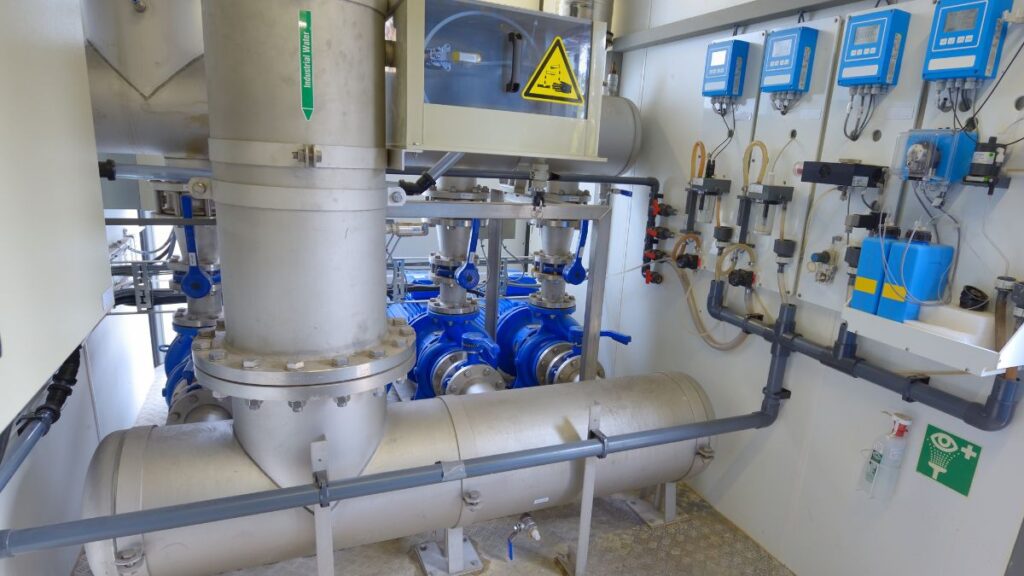In many industries, demineralized water is an absolute necessity—both for chemical processes, boiler systems, cooling towers, and high-precision electronic production. The demineralization process aims to remove dissolved ions such as calcium, magnesium, sodium, chloride, sulfate, and others, so that the water is not corrosive, does not cause scale, and does not interfere with ongoing chemical reactions.
However, one challenge that often arises even after the process is complete is that demineralized water still contains silica (SiO₂). Not a few industries assume that demineralized water is clean from all contaminants, when in fact silica can still escape the standard demineralization system.
Why is Silica Content a Problem?
Silica is not just an ordinary contaminant. In the industrial context—especially power plants, electronics manufacturing, the chemical industry, and even pharmaceuticals—the presence of silica in process water can cause major losses. Here are some reasons why silica should be a major concern.
1. Scale in Heating Systems
Silica carried in process water can form very hard scales inside boilers, heat exchangers, or high-pressure pipes. Unlike calcium-based scales, silica scales are very difficult to remove, even with strong chemicals.
Read Also: Scaling and Corrosion in Boilers: A Hidden Threat to Face
2. Damage to Turbines and Precision Equipment
In power plants, steam from demineralized water is used to drive turbines. If the water still contains silica, the silica will be carried along with the steam and deposited on the turbine surfaces, causing reduced efficiency or permanent damage.
3. Production Process Contamination
In the semiconductor or pharmaceutical industries, even the slightest presence of silica can cause serious contamination, ruining production batches and potentially causing significant financial losses.
Why Does Silica Remain After Demineralization?
Although cation-anion mixbed demineralization systems are very effective in removing dissolved ions, they are not completely effective in removing silica. Here are some reasons why silica remains after demineralization.
1. Types of Silica Not Filtered by Resin
Silica is present in two main forms in water:
- Dissolved silica, in the form of silicic acid (H₄SiO₄), which is an ionic form and is relatively easy to remove by ion exchange resins.
- Colloidal silica, in the form of suspended microscopic particles, which are uncharged and unaffected by ion exchange resins.
Most demineralization systems are only effective against ionic forms, while colloidal forms are not adsorbed by ion exchange resins and are therefore carried over into the final product.
2. Decreased Efficiency of Ion Exchange Resins
Prolonged use of resins without optimal regeneration will reduce the ion exchange capacity, including for removing silica. Saturated or contaminated resin will cause silica to leak into the product water.
3. Inadequate System Design
Some demineralization systems are not designed to handle raw water with high silica content. Without proper pre-treatment such as ultrafiltration or special coagulation, colloidal silica will remain in the system until the final stage.
4. Unstable Operating Conditions
Variations in pressure, temperature, and water flow in the demineralization system can also affect the effectiveness of the silica reduction process. In addition, changes in pH in the process can also cause changes in the form of silica from dissolved to colloidal.
Solutions to Overcome Silica Content in Demineralized Water
The problem of silica in demineralized water does not mean that it cannot be overcome. With a systematic approach, selection of the right technology, and optimal system maintenance, silica content can be reduced to a minimum.
The following is an end-to-end approach that can be applied.
1. Raw Water Analysis and System Audit
An important initial step is to conduct a thorough analysis of the raw water, as well as an audit of the demineralization system that is already running. Lautan Air Indonesia provides comprehensive water quality survey and analysis services to determine whether the silica source is in colloidal or ionic form.
2. Optimization of Pre-Treatment System
For colloidal silica, the role of the pre-treatment system is crucial. Several solutions that can be applied:
- Coagulation and Flocculation: With special chemicals, colloidal silica particles can be combined into large flocs that are easier to filter.
- Ultrafiltration (UF): This membrane system is very effective in removing colloidal silica particles that cannot be handled by resin.
Lautan Air Indonesia has a complete line of coagulant chemicals and UF membrane systems that have been proven effective in various industrial sectors.
3. Selection of Resins Specific to Silica
Not all ion exchange resins are able to handle silica well. Lautan Air Indonesia provides high-performance ion exchange resins that are specifically designed for applications targeting silica removal.
Read Also: Resin Fouling: Causes, Impacts, and How to Prevent It in Ion Exchange Systems
4. Implementation of Mixed Bed or EDI System
For ultra-pure water, such as that required in the electronics and pharmaceutical industries, the Mixed Bed or Electrodeionization (EDI) system can be used to polish the final result of the demineralization system. Both of these systems are very effective in reducing silica content to below 10 ppb.
5. Periodic Monitoring and Maintenance
Control of water quality is not sufficient to be done periodically manually. A real-time monitoring system is needed so that any potential silica leak can be anticipated immediately. Lautan Air Indonesia offers digital monitoring solutions and IoT-based controller systems to monitor water parameters such as TDS, silica, and conductivity automatically.
Conclusion
Although demineralized water is designed to be free from mineral ions, silica can still escape into the system if not handled properly. This can have serious impacts on industrial processes, ranging from scale formation to equipment damage and product contamination.
However, with a structured approach—starting from water analysis, pre-treatment optimization, selecting the right resin, to implementing advanced technologies such as EDI and digital monitoring systems—the silica problem can be overcome effectively.
Lautan Air Indonesia is here as your trusted partner in providing comprehensive industrial water treatment solutions.
Contact us today for a free consultation and find out how we can help your water system become cleaner, more efficient, and risk-free.



